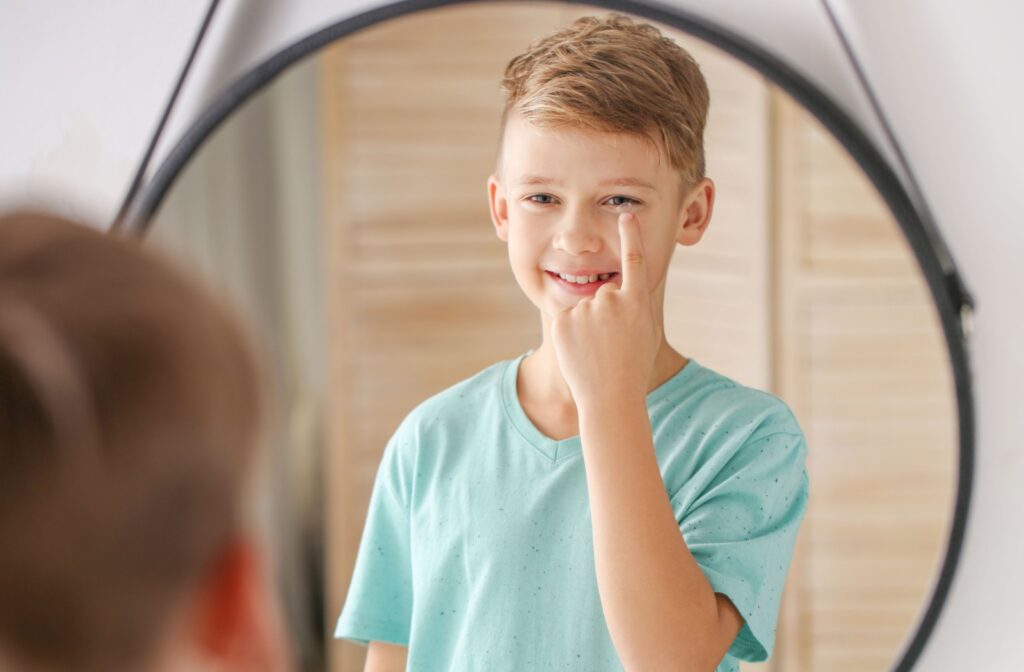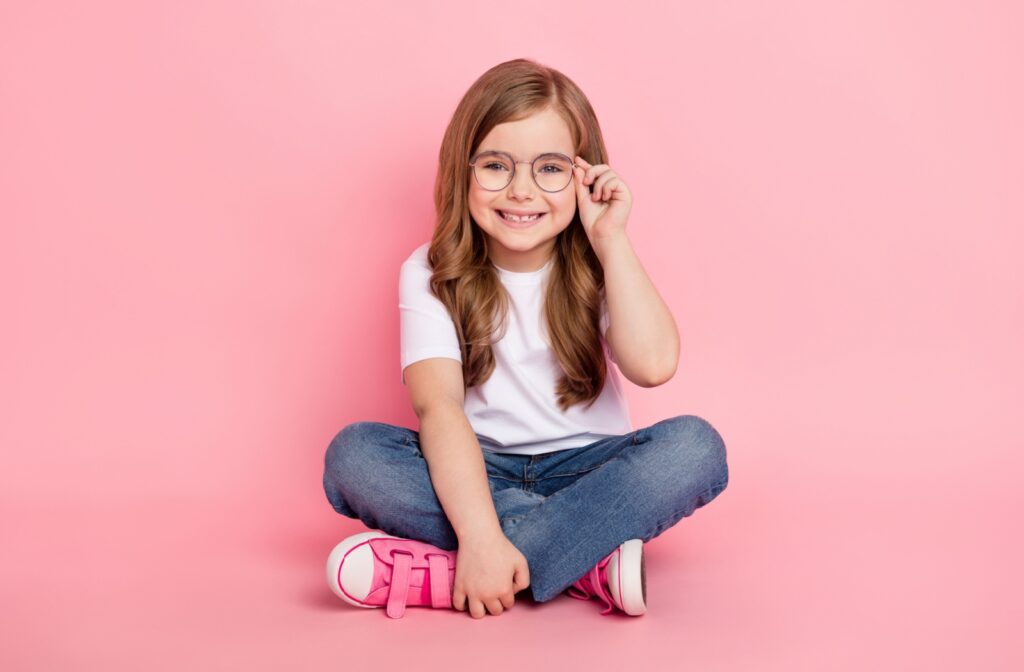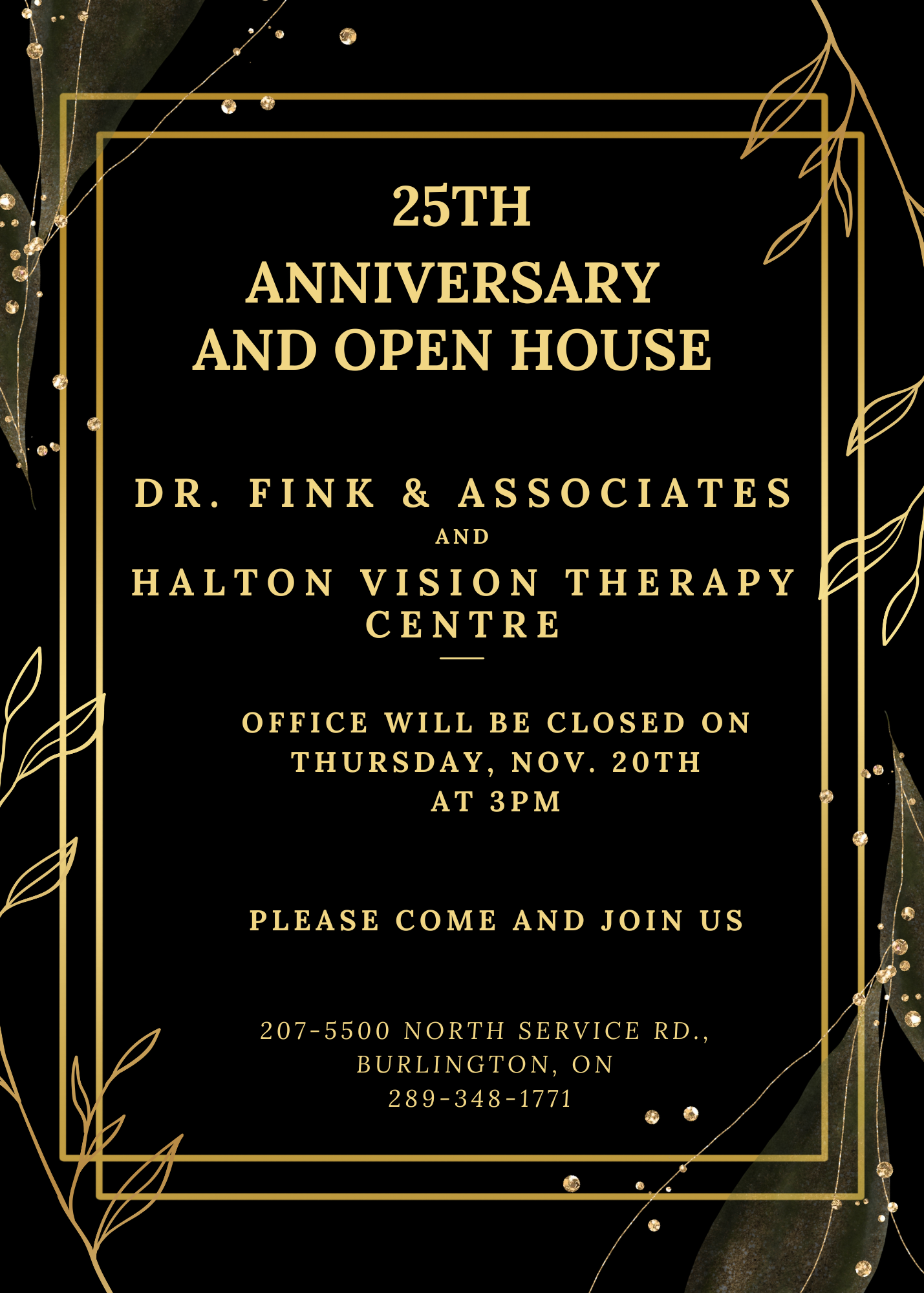Hearing that your child is nearsighted often leads to a lot of questions. It’s natural to wonder what this means for their future, and to hope there’s a way to undo it.
While there’s currently no way to reverse myopia once it develops, there are effective strategies to slow its progression and protect your child’s long-term eye health. Our goal is to keep changes in prescription as small as possible while your child grows through myopia control.
At Dr. Fink Optometry, we also focus on prevention whenever possible. We begin watching for early signs of myopia during a child’s first comprehensive eye exams — often in the preschool or early-elementary years — when the visual system is still developing.
In healthy development, a child’s eyes typically maintain a slight “plus” prescription for distance and balanced coordination for near focus. (Clinically, we look for about +0.75 in distance refraction and 4–6 exophoria for near posture.) If we see those numbers beginning to shift toward myopia, we can step in early — sometimes with a gentle near-vision or anti-fatigue lens — to reduce the visual stress that often triggers myopia in the first place.
This proactive care helps us support healthy visual development before stronger prescriptions are needed.
Catching Myopia Early: What Parents & Doctors Look For
A Simple Look at Nearsightedness
Myopia, often called nearsightedness, is a common vision condition where you can see objects close to you clearly, but objects farther away are blurry. This happens when the eye grows a little too long from front to back. As a result, light focuses in front of the retina instead of directly on it, which causes distant objects to appear out of focus.
Common Signs in Children
Your child might not always tell you if their vision is blurry, so it helps to watch for certain signs. You may notice them:
- Squinting to see the board at school or the television
- Sitting very close to screens or holding books close to their face
- Complaining of frequent headaches or tired eyes
- Rubbing their eyes often
These behaviours are often your child’s way of trying to make their vision clearer without realizing there is an issue.
Why Nearsightedness Develops
Several factors can influence myopia in children. Family history often plays a part — if you or your partner are nearsighted, your child’s risk is higher.
Daily habits also matter: long periods of reading or screen time, especially at a close distance, may add extra strain to the eyes and contribute to myopia’s progression in children who are already predisposed.
Eye doctors continue to study whether the prescription change triggers the eye to grow longer or if the growth comes first. When a child shows signs of myopia for the first time, we can’t always tell right away how much of that blur is true myopia and how much may be “pseudomyopia” — a temporary focusing issue often linked to near-work fatigue.
The encouraging part is that pseudomyopia can sometimes be improved or even reversed with the right lenses or vision-therapy strategies. Follow-up exams and monitoring over time allow us to separate what’s temporary from what’s permanent so we can choose the best approach for your child.
Regular exams and early follow-up visits are essential to slowing true myopia and addressing any reversible focusing problems promptly.
The Role of Early Development & Primitive Reflexes
Healthy visual development begins in infancy, long before a child needs glasses. Certain automatic responses present at birth—called primitive reflexes—help guide early movement and coordination. As a child grows, these reflexes should gradually integrate so that the visual system can develop more refined focusing and eye-tracking skills.
At Dr. Fink Optometry, we include primitive reflex testing as part of our children’s eye care. When these reflexes remain active longer than expected, they can sometimes affect how the eyes coordinate for distance and near vision. Our team provides targeted vision-therapy strategies—even for very young children—to help integrate retained reflexes and support healthy visual development.
By nurturing this early foundation, we can reduce visual stress on the eyes and give children the best chance to maintain normal refractive status—an important step in helping prevent or slow the onset of myopia.
The Question of Myopia Management & Reversal
Can You Reverse Myopia?
This is a question we hear a lot from concerned parents. Currently, there is no treatment that can reverse or cure myopia because it involves the physical length of the eye. Once the eye has grown to a certain length, it cannot be shortened.
The goal of modern eye care is to slow down its progression. This is most effective during childhood and teenage years when eyes grow the most.
The Importance of Myopia Management
While we can’t reverse it, we can create a plan for myopia management in Burlington. Slowing the progression of myopia is important for your child’s future eye health. An effective management plan can help reduce the need for stronger prescription changes year after year.
Slower progression can also help lower the risk of developing other eye conditions later in life. It’s a proactive step toward protecting their vision for years to come.
Options for Myopia Management in Burlington
Specialty Myopia-Control Glasses
For children who prefer glasses over contacts, we also offer specialty myopia-control glasses, including the Essilor Stellest® and MiyoSmart® lenses. These advanced glasses look and feel like regular eyewear but use specially designed optical zones to help slow the progression of myopia while providing clear distance vision. This option can be an excellent choice for younger children or those not ready for contact lenses.
Specialty Contact Lenses
Certain types of multifocal soft contact lenses are designed to help slow down the progression of myopia. These lenses have different zones of focus that help correct blurry distance vision while simultaneously signaling the eye to slow its growth. They are worn during the day, just like regular contact lenses, and with guidance from our team on proper wear and care, many children adapt to them with ease.
Atropine Eye Drops
Low-dose atropine eye drops are another option we may discuss for your child. These prescription drops are typically used once a day alongside their regular glasses or contact lenses. Research shows that they can help relax the eye’s focusing system and slow the progression of myopia in some children.
At Dr. Fink Optometry, we take a careful, individualized approach with atropine. The exact way it works to slow myopia isn’t fully understood, and it’s considered an off-label use of the medication. Because some children may be more prone to side effects, we review each case thoroughly before recommending this treatment.
Vision Therapy & Your Child
Vision issues related to eye coordination or focusing often occur alongside myopia.
Myopia is fundamentally linked to binocular-vision function. When the eyes can’t coordinate properly for both distance and near tasks, the brain may struggle to switch between them. Teaching a child early to use their eyes efficiently at all distances can help prevent or slow the progression of myopia.
Specialty lenses, and in some cases low-dose atropine, can sometimes provide the visual support a child needs to start using their eyes more comfortably at near-vision activities. However, many children benefit most from active vision therapy, which helps them consciously change how they approach near work. Our personalized in-office sessions use targeted activities and exercises to train the eyes and brain to work together more effectively.
We also integrate other supportive therapies into our myopia-management vision-therapy program:
- Photobiomodulation (Red-Light / Syntonic Therapy): We use gentle red-light therapy as part of our program because it stimulates the mitochondria within the cells. Healthy mitochondrial activity supports overall eye health, and a loss of mitochondrial function has been linked to a variety of eye-health challenges.
- Nutritional & Lifestyle Counselling: During every child’s eye exam, we review Harmon’s distance posture for all near-point tasks to help reduce visual stress. We encourage families to prioritize regular outdoor activity to enhance distance viewing and exercise — both of which can support healthier mitochondrial function. We also help families find a better balance between near-work time (like screens and reading) and outdoor time, which often reveals how skewed up-close time has become in daily routines.
These combined strategies create a comprehensive, whole-child approach to addressing underlying visual-system challenges and supporting long-term eye health.

The Role of a Comprehensive Children’s Eye Exam
More Than Just an Eye Chart
A thorough children’s eye exam goes far beyond reading letters on a chart. We check the overall health of your child’s eyes, measure their precise prescription, and assess how their eyes work together as a team. This gives us a complete picture of their visual system and any underlying issues.
Create a Personalized Plan
Every child’s eyes are unique, so their eye care plan should be too. The visual system is fluid, which means it changes regularly to adapt to the environment and the person’s growth. The eye care plan needs to be monitored and adapted regularly for each child. Based on the results of the eye exam, we can talk about a personalized strategy for your child. This plan considers their age, prescription, lifestyle, and the rate of their myopia progression.
The Value of Outdoor Time
Encouraging your child to spend more time outdoors is a simple but powerful way to support their eye health. Regular outdoor play — ideally about two hours a day — has been shown to slow the progression of myopia.
Just as important as outdoor time is maintaining a healthy balance between close-up tasks (like reading and screen time) and time spent focusing on distant objects outdoors. We often find that when families compare the two, they realize how much of their child’s day is spent up close.
Helping kids shift that balance, even gradually, can have a meaningful impact on their visual comfort and long-term eye health.
Supporting Your Child’s Vision for the Future
Myopia can’t be reversed once it begins — but with the right care, it can often be slowed or even prevented from developing in the first place.
At Dr. Fink Optometry, we know that a child’s eyes develop best when their distance prescription stays close to a mild “plus” range (around +0.75) and their near-focus posture remains well-balanced (about 4–6 exophoria). These changes can start quietly, before a child notices any symptoms — which is why early and regular eye exams are so important.
By checking these key measurements as children grow, we can step in sooner, sometimes with a gentle preventive near-vision prescription, to reduce stress on the eyes before myopia progresses.
Consistent eye exams give us the best chance to guide healthy visual development and protect your child’s long-term eye health.Book your child’s eye exam at Dr. Patricia Fink Optometry in Burlington to see how a personalized myopia-management plan can help protect their eyesight for years to come.




